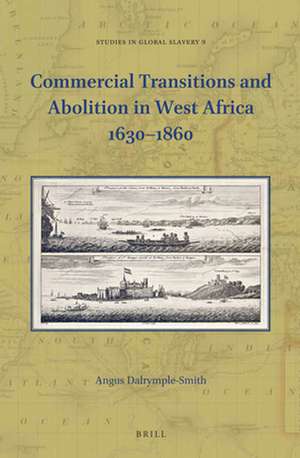Commercial Transitions and Abolition in West Africa 1630–1860: Studies in Global Slavery, cartea 9
Autor Angus E. Dalrymple-Smithen Limba Engleză Paperback – 3 mar 2021
It argues that the timing and nature of the change from slave exports to so-called ‘legitimate commerce’ in the Gold Coast, the Bight of Biafra and the Bight of Benin, can be predicted by patterns of trade established in previous centuries by a range of African and European actors responding to the changing political and economic environments of the Atlantic world.
Preț: 308.74 lei
Nou
Puncte Express: 463
Preț estimativ în valută:
59.08€ • 61.85$ • 48.88£
59.08€ • 61.85$ • 48.88£
Carte indisponibilă temporar
Doresc să fiu notificat când acest titlu va fi disponibil:
Se trimite...
Preluare comenzi: 021 569.72.76
Specificații
ISBN-13: 9789004460898
ISBN-10: 9004460896
Dimensiuni: 155 x 235 mm
Greutate: 0.39 kg
Editura: Brill
Colecția Brill
Seria Studies in Global Slavery
ISBN-10: 9004460896
Dimensiuni: 155 x 235 mm
Greutate: 0.39 kg
Editura: Brill
Colecția Brill
Seria Studies in Global Slavery
Cuprins
List of Figures, Maps and Tables
List of Appendices
Introduction: Historiography of the Commercial Transition
1 From Slaves to ‘legitimate commerce’: Different Places, Different Times
2 West African Trade with the Atlantic World
3 Accounting for Regional Differences
4 Organisation
1 Regional Patterns of (Non-Slave) Trade in the First Half of the Eighteenth Century
1 The Commodity Trade in the Early Eighteenth Century
2 Trade in Africa in the Eighteenth Century
2 Commercial Agriculture and Slave Ship Provisioning 1680–1800
1 Did the Transatlantic Slave Trade Boost West African Commercial Agriculture?
2 Main Results
3 Changing Relative Prices and Trade Risks
4 Revised Estimates of West African Food Exports, 1681–1807
5 Why did British Provisioning Strategies Differ and What were the Impacts on Different Regions?
3 The Transatlantic Slave and Commodity Trades in the Second Half of the Eighteenth Century
1 Measuring the Volume and Value of the Commodity Trade
2 Real Value and Structure of West Africa’s Commodity Trade
3 Regional Trade
4 Market Exchange and the Slave Trade
4 The Gold Coast: Gold, Wealth and Power Amongst the Akans
1 Long-term Trade Contacts
2 A New Interpretation of the Impact of Abolition
3 Economic and Political Considerations in 1808
4 Gold and the Asante State
5 Household Labour Decisions
5 The Bight of Biafra: From Export Slavery to Slave Production
1 External Trade
2 The Value of the Commodity Trade and ‘comey’
3 Britain and Palm Oil Trading
4 Institutional Development in Biafra
5 The Demand for Labour and the Internal Slave Trade
6 Household Production of Palm Oil
6 The Bight of Benin: Dahomey and the Dominance of Export Slavery
1 Long-term Trends in Dahomey’s Trade
2 Comparative Value of the Slave and Commodity Trades
3 Trading Partners
4 Dahomean Militarism
5 Militarism and Labour
Conclusion
1 Long-Term Patterns of Trade
2 Diverging Trajectories
3 The Real Impact of Britain’s Abolition Campaign
4 Implications and Future Research
Bibliography
Published Contemporary Sources
Secondary Sources
Online Sources
Index
List of Appendices
Introduction: Historiography of the Commercial Transition
1 From Slaves to ‘legitimate commerce’: Different Places, Different Times
2 West African Trade with the Atlantic World
3 Accounting for Regional Differences
4 Organisation
Part 1
Trends in the (Non-Slave) Trade with West Africa Over the Eighteenth Century
1 Regional Patterns of (Non-Slave) Trade in the First Half of the Eighteenth Century
1 The Commodity Trade in the Early Eighteenth Century
2 Trade in Africa in the Eighteenth Century
2 Commercial Agriculture and Slave Ship Provisioning 1680–1800
1 Did the Transatlantic Slave Trade Boost West African Commercial Agriculture?
2 Main Results
3 Changing Relative Prices and Trade Risks
4 Revised Estimates of West African Food Exports, 1681–1807
5 Why did British Provisioning Strategies Differ and What were the Impacts on Different Regions?
3 The Transatlantic Slave and Commodity Trades in the Second Half of the Eighteenth Century
1 Measuring the Volume and Value of the Commodity Trade
2 Real Value and Structure of West Africa’s Commodity Trade
3 Regional Trade
4 Market Exchange and the Slave Trade
Part 2
The Long-Term Roots of the Commercial Transitions: Case Studies
4 The Gold Coast: Gold, Wealth and Power Amongst the Akans
1 Long-term Trade Contacts
2 A New Interpretation of the Impact of Abolition
3 Economic and Political Considerations in 1808
4 Gold and the Asante State
5 Household Labour Decisions
5 The Bight of Biafra: From Export Slavery to Slave Production
1 External Trade
2 The Value of the Commodity Trade and ‘comey’
3 Britain and Palm Oil Trading
4 Institutional Development in Biafra
5 The Demand for Labour and the Internal Slave Trade
6 Household Production of Palm Oil
6 The Bight of Benin: Dahomey and the Dominance of Export Slavery
1 Long-term Trends in Dahomey’s Trade
2 Comparative Value of the Slave and Commodity Trades
3 Trading Partners
4 Dahomean Militarism
5 Militarism and Labour
Conclusion
1 Long-Term Patterns of Trade
2 Diverging Trajectories
3 The Real Impact of Britain’s Abolition Campaign
4 Implications and Future Research
Bibliography
Published Contemporary Sources
Secondary Sources
Online Sources
Index
Notă biografică
Angus Dalrymple-Smith, Ph.D (2017), Wageningen University, is a lecturer and researcher on the impact of the transatlantic slave trade on West African economies and societies in the early modern period.














